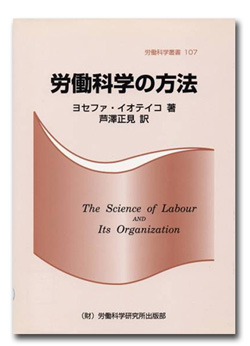History of Ergonomics
Trace ergonomics to its origin

“An outline of Ergonomics, or the Science of Work” by Wojciech Jastrzębowski (1799-1882) who defined ergonomics for the first time in the world: Central Institute of Labour Protection, Warsaw, 1997. ISBN: 83-901740-9-X or ISBN: 83-87354-59-7.

Book written by a Polish scientist, Józefa Franciszka Joteyko (1866-1928)
Book written by a Polish scientist, Józefa Franciszka Joteyko (1866-1928)
Its Japanese version (translated by Masami Ashizawa) was published in 2000 (by the Institute for Science of Labour). ISBN-10: 489760107X, ISBN-13: 978-4897601076.
The term ergonomics originally comes from the Greek words ergon (work or labor) and nomos (natural laws). The fact that the word ergonomics was coined by a Polish scholar, Wojciech Jastrzębowski, in 1857 became widely known when his book in Polish was reprinted with English translation in 1997.
The year 1857 falls in the fourth year of the Ansei period in Japan, which was the time just after the arrival of Perry and his black ships.
Association between “labor” and “health”, in other words, the kinds of “health problems” caused by “working” was often reported even in the age of ancient Egypt and the Greek and Roman period. It is in “De morbis artificum diatriba,” a classic by Bernardino Ramazzini (1633-1714), an Italian physician, that the relationship between working conditions and pathology was first systematized from an occupational health perspective. In this book, not only respiratory disorders such as asthma and tuberculosis caused by fine particles but effects of awkward working postures on workers’ bodies were referred to as diseases observed among metal mining workers. It can be said that the age of industrialization, promoted by the Industrial Revolution that started in the 18th century, demanded clarification of the relationship between labor and health.
However, the development of preventive measures based on an ergonomic perspective and ergonomic methods and approaches, such as the measurement of occupational fatigue and the establishment of principles in scientific management of labor, had to wait until the beginning of the 20th century.
In 1919 “The Science of Labour and Its Organization” by Józefa Joteyko, a Polish scientist, was published in English, in which measurement of occupational fatigue and principles in scientific management of labor were discussed in detail.
Another course of development, human factors
Another course of development of ergonomics is the research of human errors that has been pursued mainly in the US since the end of World War II. In those days accidents involving airplanes, such as one in which an aircraft of the US air force crashed into the Rocky mountains, occurred so often that the investigation team composed of specialists in psychology and aeronautical engineering probed into the cause. The conclusion was that pilots had misread the altimeter due to the bad design of its interface. Human cognitive characteristics taken into consideration, the altimeter for aircrafts was then designed to have an easy-to-read, single pointer. This is how the science of human factors has developed in the context of applied psychology. Now this scientific field is not only providing safe and comfortable designs, such as ones to prevent human errors and those found in simple and easy-to-use products for walk-up-and-use as well as consumer equipment, but is also expanding its target area to medicine, welfare, aviation, traffic systems and public facilities.
Origin of ergonomics in Japan, and modern ergonomics
The pioneer of ergonomic research in Japan was Gito Teruoka. He founded the Kurashiki Institute of Science of Labour in 1921 and became its director. That year, “Research of Efficiency: Ergonomics” by Kan-ichi Tanaka was also published. In his book Tanaka introduced human engineering to Japan, which was, unlike science of labor, based on American psychology and placed an importance on methods to utilize human power most economically. In the US, several ergonomically-renowned textbooks written by scientists such as Woodson, McCormick and Sanders have been published since the 1950s. In 1963 the first edition of a masterpiece by Grandjean, “Fitting the Task to the Man,” was published. In 1996, the IEA and the ILO jointly launched “Ergonomics Checkpoints” with easy-to-understand illustrations for the improvement of workplaces and working conditions.
The International Ergonomics Association (IEA) was founded in 1959, organizing ergonomics-related societies or associations formed in different countries/areas around the world. Its international conference is held every three years, and was hosted mainly by European cities such as Stockholm, Dortmund, Birmingham, and Strasburg in the past. However, it has also been held in cities in Asia and Australia recently: Tokyo in 1982, Sydney in 1988, Seoul in 2003 and Beijing in 2009. The Japan Ergonomics Society (JES) has actively participated in IEA activities and contributed to them in the field of human resources and funding as well. Some members of the JES have even served as its chairperson or board members. We are also ready to keep contributing to the IEA by, for example, participating in many of the science and technology committees set up in the association.

